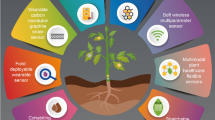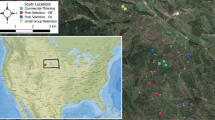Abstract
The Electric Resistance Tomograph (ERT) is a customized tree specific novel German-technology which was developed to monitor and estimate the tree growth development by looking into the inner structure of the tree to analyse the growth and health status. This technique contributes to detect and study the internal assembly of a tree for the mapping of decay, hollowness, and also to distinguish the sapwood and heartwood demarcation, this way of discovering the internal growth at an early stage, mainly for the timber trees which are economically important can help to regulate thereafter to check whether the growth is not hindered. This paper highlights the device operational methods, electric resistance testing of trees and its applications, also reviewed the various successful application of this equipment in various tree species through-out the world to estimate non-destructively for accurate quantification of standing trees. The performance of this instrument has created breakthrough among various studies and methodologies to spot the internal condition in a standing tree with less invasive ways.



Similar content being viewed by others
Availability of data and materials
All authors certify that they have no affiliations with or involvement in any organization or entity with any financial or non- financial interest in the subject matter discussed in the manuscript.
Code Availability
Not applicable.
References
Bär, A., Hamacher, M., Ganthaler, A., Losso, A., & Mayr, S. (2019). Electrical resistivity tomograph: patterns in Betula pendula, Fagus sylvatica, Picea abies and Pinus sylvestris. Tree Physiology, 39, 1262–1271. doi:https://doi.org/10.1093/treephys/tpz052
Benson, A. R., Koeser, A. K., & Morgenroth, J. (2018). Estimating conductive sapwood area in diffuse and ring porous trees with electronic resistance tomography. Tree Physiology, 00, 1–11. doi:https://doi.org/10.1093/treephys/tpy092
Bieker, D., & Rust, S. (2010). Electric resistivity tomography shows radial variation of electrolytes in Quercus robur. Canadian J of Forest Research, 40(6), 1189–1193. doi:https://doi.org/10.1139/x10-076
Bieker, D., Kehr, R. D., Weber, G., & Rust, S. (2010). Non-destructive monitoring of early stages of white rot by Trametes versicolor in Fraxinus excelsior. Annals of Forest Science, 67(2), 1–7. doi:https://doi.org/10.1051/forest/2009103
Brazee, N. J., Marra, R. E., Göcke, L., & Wassenaer, P. V. (2011). Non - destructive assessment of internal decay in three hardwood species of northeastern North America using sonic and electrical impedance tomography. Forestry, 84(1), 33–39. doi:https://doi.org/10.1093/forestry/cpq040
Divakara, B. N., Nikhitha, C. U., & Chauhan, S. S. (2020). Inventory on deciphering interiors of commercially important Indian trees using 3D Electric Resistance Tomography (ERT). Indian Forester, 146(12), 1149–1153
Divakara, B. N., Nikhitha, C. U., & Shetty, A. K. (2019). Exploring the Possibilities of Quantifying Heartwood of Tectona grandis Linn. f. Using Electrical Resistivity Tomography (ERT) for Tree Improvement In: 25th IUFRO world congress with theme “Forest Research and Cooperation for Sustainable Development” held at Curitiba, Brazil on 29th – 5th Oct, 2019
Dixon, M. A., Thompson, R. G., & Fensom, D. S. (1978). Electrical resistance measurements of water potential in avocado and white spruce. Canadian J of Forest Research, 8, 73–80. doi:https://doi.org/10.1139/x78-013
Elliott, M. L., Broschat, T. K., & Goecke, L. (2016). Preliminary evaluation of electrical resistance tomography for imaging palm trunks. Arboriculture & Urban Forestry, 42(2), 111–119
Feng, H., Li, G., Fu, S., & Wang, X. (2014). Tomographic Image Reconstruction Using an Interpolation Method for Tree Decay Detection. BioResources, 9(2), 3248–3263
Ganthaler, A., Sailer, J., Bär, A., Losso, A., & Mayr, S. (2019). Noninvasive Analysis of Tree Stems by Electrical Resistivity Tomography: Unraveling the Effects of Temperature, Water Status, and Electrode Installation. Frontiers in Plant science, 10, 1–12. doi: https://doi.org/10.3389/fpls.2019.01455
Göcke, L. (2017). PiCUS: TreeTronic Electric Resistance Tomograph. Germany: Argus Electronic GmbH, Rostock
Guyot, A., Ostergaard, K. T., Lenkopane, M., Fan, J., & Lockington, D. A. (2013). Using electrical resistivity tomography to differentiate sapwood from heartwood: application to conifers. Tree Physiology, 33, 187–194. doi:https://doi.org/10.1093/treephys/tps128
Lin, C. J., Chung, C. H., Yang, T. H., & Lin, F. C. (2012). Detection of electric resistivity tomography and evaluation of the sapwood-heartwood demarcation in three Asia gymnosperm species. Silva Fennica, 46(3), 415–424
Luo, Z., Deng, Z., Singha, K., Zhang, X., Liu, N., Zhou, Y. … Guan, H. (2020). Temporal and spatial variation in water content within living tree stems determined by electrical resistivity tomography. Agricultural and Forest Meteorology, 291, 1–9. doi:https://doi.org/10.1016/j.agrformet.2020.108058
Mann, R., Dickin, F. J., Wang, M., Dyakowski, T., Williams, R. A., Edwards, R. B. … Holden, P. J. (1997). Application of electrical resistance tomography to interrogate mixing processes at plant scale. Chemical Engineering Science, 52(13), 2087–2097. doi:https://doi.org/10.1016/s0009-2509(97)00036-5
Moreau, E., Bédard, S., Baral, S. K., & Pothier, D. (2018). Evaluating electrical resistivity tomography and crown surface area to estimate leaf area of sugar maple and yellow birch. Ecohydrology, 1–10. doi:https://doi.org/10.1002/eco.2014
Pánek, T., Hradecký, J., & Šilhán, K. (2008). Application of electrical resistivity tomography (ert) in the study of various types of slope deformations in anisotropic bedrock: case studies from the flysch carpathians. (42),57–73
Wang, H., Guan, H., Guyot, A., Simmons, C. T., & Lockington, D. A. (2015). Quantifying sapwood width for three Australian native species using electrical resistivity tomography. Ecohydrology, 9(1), 83–92
Yue, X., Wang, L., Wacker, J. P., & Zhu, Z. (2019). Electric resistance tomography and stress wave tomography for decay detection in trees—a comparison study. PeerJ, 6444, 1–16. https://doi.org/10.7717/peerj.6444
Yue, X., Wang, L., Shi, X., Xu, M., & Zhu, Z. (2018). Investigations on the Effects of Seasonal Temperature Changes on the Electrical Resistance of Living Trees. Forests, 9(550), 1–15
Acknowledgements
The authors wish to thank the Director, IWST for providing all necessary facilities for this study. Authors also express gratitude to Compensatory Afforestation Fund Management and Planning Authority (CAMPA), New Delhi for funding the project to write review.
Funding
The authors have no financial funding to disclose.
Author information
Authors and Affiliations
Contributions
Basic idea and presentation of the paper along with substantial contribution in arranging information along with proof reading of the review article was carried out by BN Divakara (First author and corresponding author). Collected the information and related works of ERT applications in different tree species from all possible sources and preparation of review article was done by Chaithra S.
Corresponding author
Ethics declarations
Conflicts of interest/Competing interests
The authors have no known conflicts of interest to declare that are relevant to the content of this article.
Additional information
Publisher’s Note
Springer Nature remains neutral with regard to jurisdictional claims in published maps and institutional affiliations.
Rights and permissions
About this article
Cite this article
Divakara, B.N., Chaithra, S. Electric Resistance Tomograph (ERT): a review as non-destructive Tool (NDT) in deciphering interiors of standing trees. Sens Imaging 23, 18 (2022). https://doi.org/10.1007/s11220-022-00385-3
Received:
Revised:
Accepted:
Published:
DOI: https://doi.org/10.1007/s11220-022-00385-3




